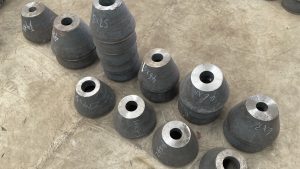Cones
In a space frame structure, cones usually refer to conical joints or node assemblies used where multiple tubular members meet at different angles, especially when forming curved, tapered, or funnel-like shapes.
A space frame cone is a specially fabricated, cone-shaped steel connector used to join pipes in a space frame system. It’s typically made from steel plate rolled and welded into a conical form, then machined to fit bolts or welds.
-
Used when the pipe axes don’t meet in a flat plate or spherical node.
-
Helps transition between different diameters of pipes.
-
Provides smooth load transfer between members.
Typical Applications
-
Tapered column tops – where a vertical column meets the horizontal roof grid.
-
Architectural domes – at apexes or base connections where multiple pipes converge.
-
Canopy and stadium roofs – to connect large-span trusses with angled members.
-
Transition zones – between space frames and supporting structures (concrete, steel columns, etc.).
Structure & Components
-
Cone Body: Formed from rolled steel plate (often Q235/Q355 in China, ASTM A36/A572 abroad).
-
Flange Plate: Bolted to other components or welded to pipe ends.
-
Sleeve/Socket: Sometimes the cone has a cylindrical sleeve at the narrow end to connect to a smaller-diameter member.
-
Reinforcement Ring: To resist local bending at the connection point.
Advantages
-
Allows multi-directional connection with precise angles.
-
Reduces stress concentration compared to flat plates.
-
Can handle larger loads than simpler welded T-joints.
-
Aesthetic smooth transitions in visible structures.
Fabrication Notes
-
CNC plasma cutting for precision edge shapes.
-
Full penetration welds for high-strength joints.
-
Often hot-dip galvanized or epoxy painted for corrosion resistance.
-
Angle accuracy is crucial — usually tolerance ≤ 1°.


